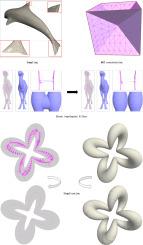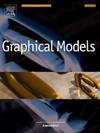A detail-preserving method for medial mesh computation in triangular meshes
IF 2.2
4区 计算机科学
Q2 COMPUTER SCIENCE, SOFTWARE ENGINEERING
引用次数: 0
Abstract
The medial axis transform (MAT) of an object is the set of all points inside the object that have more than one closest point on the object’s boundary. Representing sharp edges and corners of triangular meshes using MAT poses a complex challenge. While some researchers have proposed using zero-radius medial spheres to depict these features, they have not clearly articulated how to establish proper connections among them. In this paper, we propose a novel framework for computing MAT of a triangular mesh while preserving its features. The initial medial axis mesh obtained may contain erroneous edges, which are discussed and addressed in Section 3.3. Furthermore, during the simplification process, it is crucial to ensure that the medial spheres remain within the confines of the triangular mesh. Our algorithm excels in preserving critical features throughout the simplification procedure, consistently ensuring that the spheres remain enclosed within the triangular mesh. Experiments on various types of 3D models demonstrate the robustness, shape fidelity, and efficiency in representation achieved by our algorithm.

三角形网格中轴网格计算的细节保护方法
对象的中轴变换(MAT)是对象内部所有点的集合,这些点在对象边界上有一个以上的最近点。使用 MAT 表示三角形网格的锐边和锐角是一项复杂的挑战。虽然一些研究人员提出使用零半径中轴球来描述这些特征,但他们并没有明确阐述如何在这些特征之间建立适当的连接。在本文中,我们提出了一种新颖的框架,用于计算三角形网格的 MAT,同时保留其特征。获得的初始中轴网格可能包含错误的边,这将在第 3.3 节中讨论和解决。此外,在简化过程中,确保中轴球体保持在三角形网格范围内至关重要。我们的算法能在整个简化过程中出色地保留关键特征,始终确保球体保持在三角形网格内。对各种类型的三维模型进行的实验证明了我们的算法在稳健性、形状保真度和表示效率方面的优势。
本文章由计算机程序翻译,如有差异,请以英文原文为准。
求助全文
约1分钟内获得全文
求助全文
来源期刊

Graphical Models
工程技术-计算机:软件工程
CiteScore
3.60
自引率
5.90%
发文量
15
审稿时长
47 days
期刊介绍:
Graphical Models is recognized internationally as a highly rated, top tier journal and is focused on the creation, geometric processing, animation, and visualization of graphical models and on their applications in engineering, science, culture, and entertainment. GMOD provides its readers with thoroughly reviewed and carefully selected papers that disseminate exciting innovations, that teach rigorous theoretical foundations, that propose robust and efficient solutions, or that describe ambitious systems or applications in a variety of topics.
We invite papers in five categories: research (contributions of novel theoretical or practical approaches or solutions), survey (opinionated views of the state-of-the-art and challenges in a specific topic), system (the architecture and implementation details of an innovative architecture for a complete system that supports model/animation design, acquisition, analysis, visualization?), application (description of a novel application of know techniques and evaluation of its impact), or lecture (an elegant and inspiring perspective on previously published results that clarifies them and teaches them in a new way).
GMOD offers its authors an accelerated review, feedback from experts in the field, immediate online publication of accepted papers, no restriction on color and length (when justified by the content) in the online version, and a broad promotion of published papers. A prestigious group of editors selected from among the premier international researchers in their fields oversees the review process.
 求助内容:
求助内容: 应助结果提醒方式:
应助结果提醒方式:


